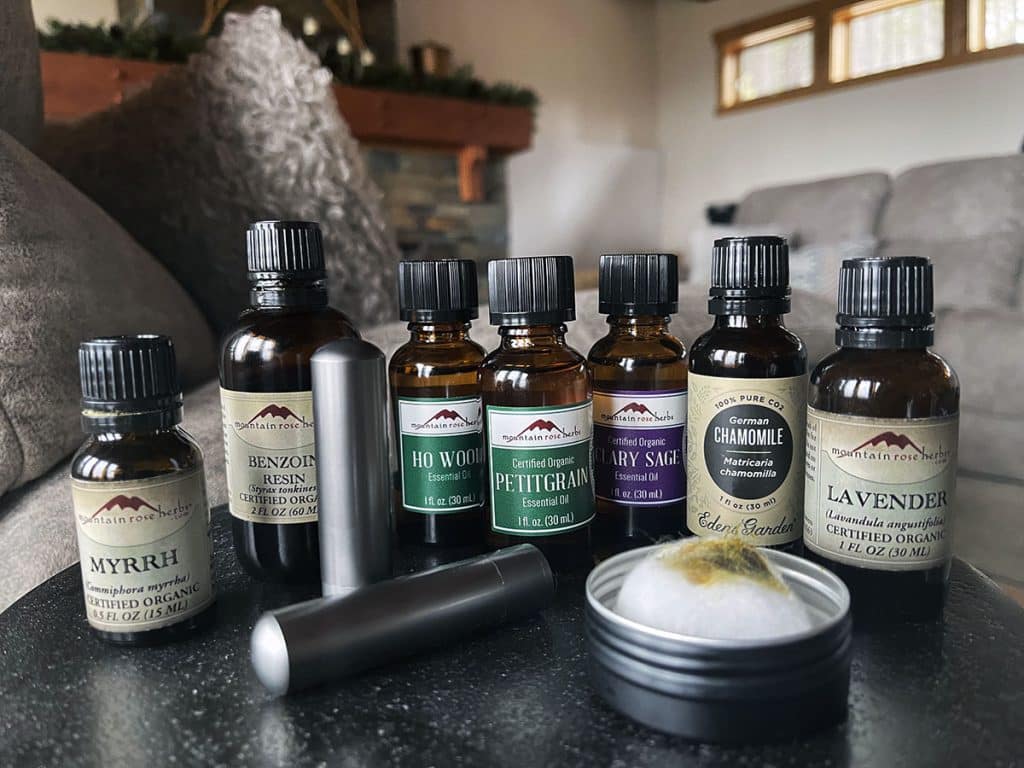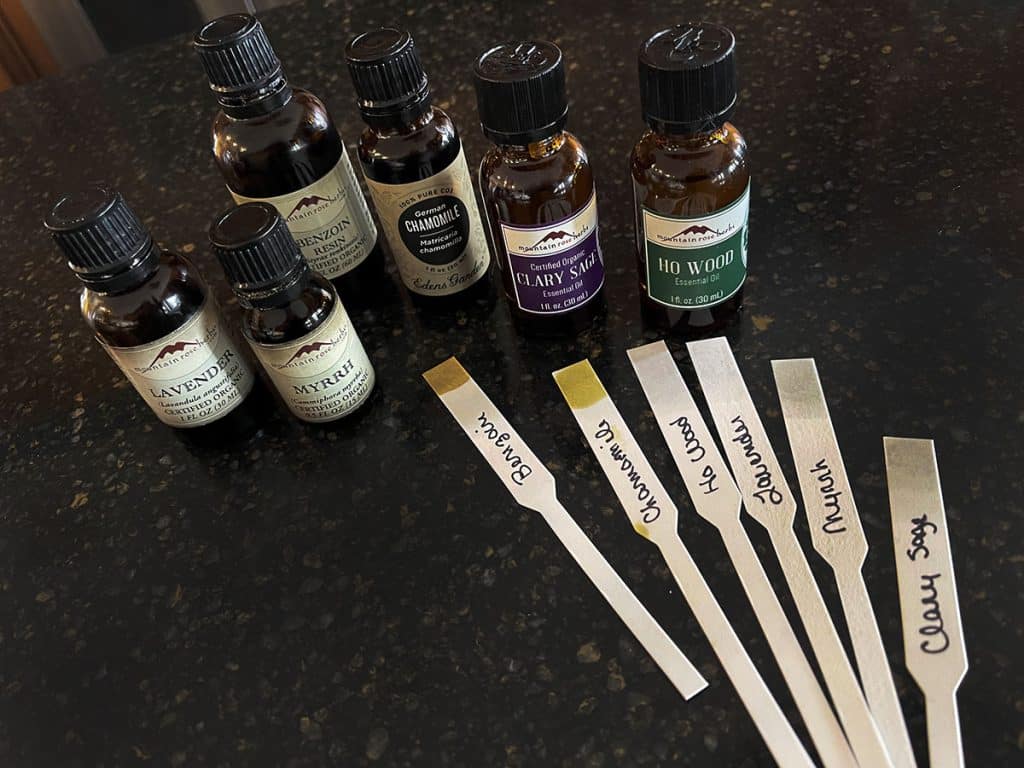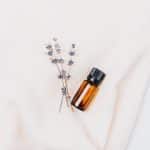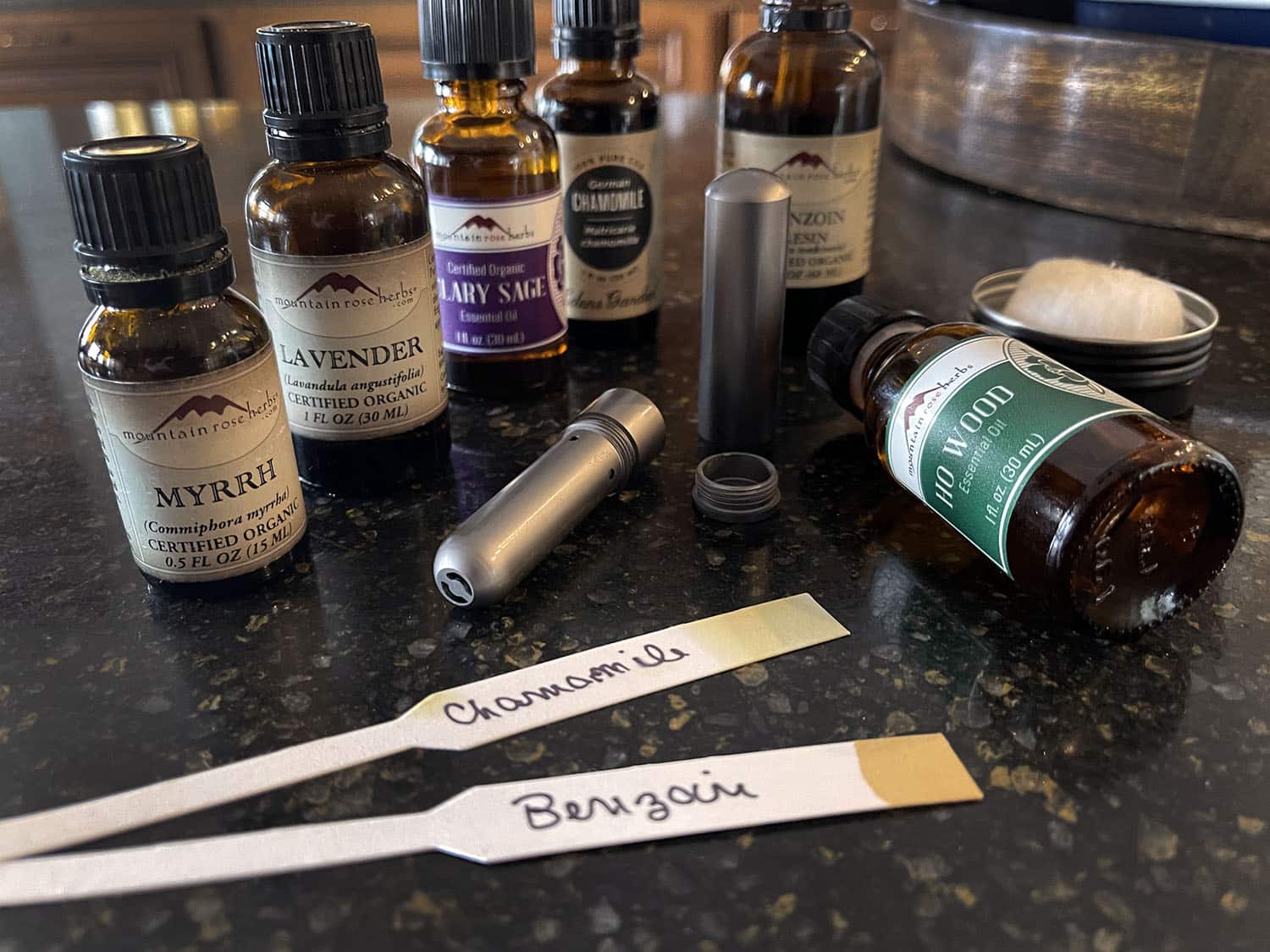From nose to brain
Aromatherapy works by stimulating the olfactory system, which is responsible for our sense of smell and is intimately connected to the limbic system in the brain. When we inhale essential oils, the odor molecules bind to olfactory receptors and send signals to the brain, triggering a response in the limbic system. This can lead to changes in mood, relaxation and other physiological and psychological responses. The limbic system, sometimes referred to as our “emotional brain,” is responsible for the regulation of emotions, stress responses, memory and regulation of the autonomic nervous system. The hypothalamus is a key structure within the limbic system and plays a critical role in regulating the body’s circadian rhythms and sleep-wake cycles. Some essential oils have sedative and calming effects that can promote relaxation and prepare the body for sleep. When inhaled, these essential oils stimulate the hypothalamus to release neurotransmitters like serotonin and GABA, which are associated with feelings of relaxation and sleepiness. Essential oils that stimulate the limbic system to release relaxing mood-regulating chemicals can be a powerful tool in your bedtime toolkit. While it’s not a substitute for healthy circadian rhythm management strategies, aromatherapy has been shown to improve sleep quality by promoting deeper, more restful sleep. Inhaling essential oils before bedtime may increase the amount of time spent in deep sleep, which is important for restoring the body and promoting overall health. For more about the olfactory system, check out this short video:A word about essential oil safety & pets
We have an indoor cat, so as much as I would like to, diffusing essential oils is not an option for us. Cats lack the liver enzyme glucuronyl transferase that is responsible for metabolizing certain compounds found in essential oils. In particular, essential oils containing phenols, terpenes and ketones can build up in a cat’s body, leading to toxicity, illness and liver damage — or even failure in severe cases.
Cats + EOs = no bueno
Dogs are generally less sensitive to essential oils, but there are certain oils that are toxic to dogs as well. Tea tree, cinnamon, citrus (i.e. lemon, orange, grapefruit), pennyroyal, peppermint, pine, wintergreen and ylang-ylang are a few common oils to avoid if you have dogs in your home. Remember that dogs have a much more acute sense of smell than we do, so a concentrated essential oil diffused into the air may be overwhelming and uncomfortable for them, even if there is no specific toxicity.
It’s a good idea to consult with your veterinarian before using any essential oils on or around your pets.
Fortunately, there are more personal ways to administer essential oils that minimize any risk to our four-legged babies. In addition to situations like ours where we don’t want our kitty cat exposed to essential oils that may be toxic to her, it turns out that diffusing an essential oil into our airspace for hours everyday may not be the best idea for us either.

Less is more
Over the last few months, I’ve been working my way through the Tisserand Institute’s Aromatic Skincare course, taught by Robert Tisserand, author of the excellent Essential Oil Safety: A Guide for Health Care Professionals (highly recommend!) Coincidentally, right now I’m in the ‘Essential Oil Safety Masterclass’ segment of the course. Robert generally recommends a conservative “less is more” approach to essential oil therapy.
Think about what happens when you walk into a room and smell something strong and unusual. It initially hits you like a ton of bricks, then seems to dissipate, and a few minutes later, you can’t really smell it anymore. More than likely, the odor is still there, your nose just got used to it. The same thing happens with essential oils. Olfactory habituation to an essential oil can cause its therapeutic effects to (temporarily) wear off. The more concentrated the essential oil, the faster habituation can occur.
According to EcoWatch, it takes 250 pounds of lavender to make 1 pound of essential oil. That’s just over 15 1/2 pounds of lavender for 1 ounce of EO.
Hope Hill Lavender Farm produces its own lavender essential oil, and according their website, it takes them 11 pounds of lavender to make 1 ounce of EO.
In their 2023 product guide, doTerra cites approximately 1.36 kg of lavender to produce 15 mL of essential oil (or about 6 pounds of lavender to 1 ounce of EO).
That’s quite a bit of discrepancy. So who’s right?
Short answer: I don’t know.
Differences in the timing of harvest, weather patterns and soil nutrients may account for some of it. In addition, certain lavender varieties are selectively bred to produce more oil per plant. For example, common lavender (Lavandula angustifolia) typically yields 0.5 to 1% oil. Whereas lavandin (Lavandula x intermedia), a hybrid lavender, yields 1.5 to 3% oil.
However you slice it, that’s a whole lotta lavender!
This is why it’s helpful to think “less is more” when it comes to using and diffusing essential oils. Yes, they are natural substances, but in wildly unatural concentrations!
Prevent aromatherapy sensitization & burnout
For most applications, practicing intermittent aromatherapy is probably a good idea. This means using the oils for short periods of time and then taking a break before using them again.
Generally speaking, the longer you’re exposed to a substance without a break, the more likely you are to develop a sensitivity to it. Essential oil sensitization is a type of delayed hypersensitivity reaction that occurs after repeated exposure to an essential oil, resulting in an immune response. This reaction can occur even in individuals who have previously used the oil without any issues.
It’s simple to practice intermittent aromatherapy — either take a break from using a specific essential oil or rotate the oil you’re using. If you like to diffuse your oils, you can also get an essential oil diffuser with a helpful intermittent mode built into it.
Oils can also be applied topically or added to a pre-bedtime bath of epsom foot soak (always diluted in a carrier oil, of course!) Essential oils are not water soluble and will not dissolve in your bathwater, putting you at risk for skin irritation and even burns. The carrier oil will help to disperse the essential oil throughout the water, ensuring that your skin never comes into contact with the full-strength essential oil.
Another option is an aromatherapy inhaler. Inexpensive nasal inhalers with an inner cotton wick are a simple and convenient tool for administering aromatherapy. Next to topical preparations, this is my favorite way to deliver essential oils. It’s very portable — about the size of a tube of lipstick — so you can take a whiff whenever you need it. I keep one on my bedside table and another in my travel kit so I’m never without one.
Which essential oils are sleep-promoting?
The following is a list of essential oils I played around with when creating my sleep blend:
Lavender (Lavandula spp.) is likely what comes to mind when you think about essential oils for promoting relaxation and better sleep. And for a good reason! It's been used in traditional medicine for centuries. The ancient Greeks and Romans used lavender in their bath water to help soothe their nerves and promote relaxation. During the Middle Ages, it was used to treat for a range of ailments, including insomnia, nervousness and anxiety.
One of the main constituents of lavender essential oil is linalool, which is known for its calming and relaxing effects on the body and mind. Linalyl acetate has been shown to have sedative effects and to promote relaxation, helping to reduce stress and promote feelings of calm. Lavandulol interacts with GABA receptors in the brain, resulting in a calming effect on the nervous system. Lavandulyl acetate has been found to have anxiolytic effects (i.e. it reduces feelings of anxiety) by inhibiting the activity of certain enzymes that break down mood regulating neurotransmitters like serotonin and norepinephrine.
Ho wood (Cinnamomum camphora) is another essential oil that's known for its calming and relaxing effects. In In traditional medicine, rosewood (Aniba rosaeodora) essential oil was highly valued for its grounding effects on the mind and body, and was often used to promote relaxation, reduce stress and to improve mood. However, due to concerns over the sustainability of the slow-growing rosewood trees, ho wood essential oil has become a popular substitute for rosewood in aromatherapy blends, as it has a similar chemical composition and aroma to rosewood and is a more sustainable alternative.
One of ho wood's main constituents is linalool which, as we talked about in lavender, is well known for its relaxing and sedative effects on the nervous system. Ho wood also contains camphor, which can alleviate muscle tension and promote relaxation. It can also help to open up the sinuses (in case nasal congestion is one of the things standing between you and a restful night's sleep!) Several other chemical constituents may also contribute to ho wood's therapeutic benefits, including geraniol, linalyl acetate and eucalyptol.
Myrrh essential oil is derived from the resin of the Commiphora myrrha tree and has a lovely warm, grounding scent. Its use as a relaxant can be traced back to ancient Egypt where it was commonly used as an incense in religious ceremonies and in embalming. Myrrh was also used in cosmetics and perfumes and was one of the key commodities traded along the ancient trade route known as the Silk Road, which connected the East and the West.
The phytochemicals that contribute to myrrh's aromatherapeutic benefits as a relaxant include various sesquiterpenes and terpenoids. Myrrh's sesquiterpenes, particularly the sesquiterpene curzerene, have been found to provide calming and sedative effects, helping to reduce feelings of anxiety, stress and restlessness. Myrrh also contains various terpenoids such as alpha-pinene, limonene, and beta-caryophyllene, all of which have sedative effects and may help to promote sleep.
Valerian (Valeriana officinalis) is another well known herb famous for its potent sedative and relaxing effects. Valerian was used in ancient Greece and Rome as a sedative and sleep aid and was traded as a commodity throughout Europe and Asia. In medieval Europe, valerian root was commonly used to treat nervous disorders and was considered a staple remedy for promoting relaxation and improving sleep.
One of the primary constituents in valerian essential oil is valerenic acid, which works by increasing the amount of GABA (gamma-aminobutyric acid) in the brain. GABA is a neurotransmitter that helps to regulate anxiety and promote relaxation. Valerian also contains bornyl acetate, which is known for its pleasant, woodsy aroma, and may help to reduce feelings of stress and anxiety. Isovaleric acid also has a sedative effect on the body and is responsible for the strong, pungent odor of the plant that some people dislike. It may be an acquired smell, but isovaleric acid can promote relaxation and reduce feelings of anxiety and stress, all of which can interfere with sleep.
Clary sage (Salvia sclarea) has been used for centuries as a natural remedy for promoting sleep and reducing anxiety. Native to the Mediterranean region, the ancient Greeks and Romans used clary sage as a natural remedy for a variety of ailments, including nervous tension and anxiety.
Some of the constituents in clary sage essential oil that lend themselves to aromatherapeutic sleep aid include linalyl acetate, linalool, geranyl acetate and sclareol. Linalyl acetate is known for its calming and soothing effects on the nervous system, and linalool has sedative and anxiolytic (anti-anxiety) properties. Geranyl acetate contributes a sweet, floral and slightly fruity aroma as well as sedative and anxiolytic effects. Clary sage's musky smelling diterpene sclareol contributes antidepressant and anti-anxiety actions, both of which can help to quiet an overactive mind and prepare you for sleep.
German chamomile (Matricaria chamomilla) is one of the best-known nervine herbs, often used in aromatherapy for promoting relaxation and improving sleep quality. The small herbaceous plant is native to Europe, and has been cultivated for its calming and soothing properties for thousands of years.
Chamazulene is responsible for German chamomile's deep blue color, and it has been shown to have anti-inflammatory, analgesic and sedative properties. I much prefer the scent of CO2-extracted German chamomile over steam-distilled, so the one I’m using will not contain chamazulene. German chamomile's constituent matricin converts to chamazulene during the heated extraction process, so CO2-extracted chamomile oil will not contain chamazulene. That said, matricin itself has been shown to have sedative and anxiolytic effects, which may help to promote relaxation and improve sleep quality when inhaled.
In addition to matricin/chamazulene, German chamomile also contains bisabolol, apigenin and linalool, all of which can also help to reduce anxiety and promote relaxation.
Petitgrain (Citrus aurantium) is distilled from the leaves and twigs of the bitter orange tree and contributes a fresh, citrusy aroma to our sleep inhaler.
In traditional medicine specifically in the Mediterranean region, the bitter orange tree was valued for its medicinal properties and calming, sedative effects. Petitgrain contains several of the same constituents we talked about earlier, including linalool, linalyl acetate, geranyl acetate and a-Terpineo, all of which have sedative and anxiolytic effects that can help to promote relaxation. These compounds interact with GABA neurotransmitters in the brain, helping to reduce anxiety and promote relaxation.
The essential oil of sweet marjoram (Origanum majorana) has been traditionally used as a calming sedative and a natural remedy for insomnia and other sleep disorders. The aromatic Mediterranean native has been cultivated for its medicinal and culinary properties for thousands of years. The ancient Greeks and Romans used sweet marjoram as a medicinal herb to treat various ailments, including digestive problems, respiratory infections and nervous disorders.
In addition to the terpene linalool, it contains additional terpenes Terpinen-4-ol, a compound with sedative properties that can help reduce anxiety and stress and y-Terpinene, known for its calming, anti-inflammatory and analgesic properties. Terpineol is yet another terpene that contributes sweet marjoram's pleasant, herbaceous floral scent and is known for its sedative and anxiolytic properties.
Tangerine (Citrus reticulata) essential oil has a long history of use in Traditional Chinese Medicine (TCM) for its digestive and respiratory benefits. More recently, it has become popular in aromatherapy for its calming and uplifting properties.
Tangerine essential oil is extracted from the peel of the fruit and contains several constituents that contribute to its potential sedative effects, including the terpenes limonene, myrcene and terpinolene. Limonene is found in most citrus essential oils and has been shown to have calming and relaxing properties. Myrcene is known for its sedative and analgesic effects and the terpene terpinolene has been found to have sedative effects as well.
One study done on the aromatherapy effects of tangerine on brain waves, moods and sleep onset latency found that inhalation of tangerine essential oil not only had a calming effect on mood and decreased anxiety, it also increased slow-wave sleep and shortened the amount of time it took participants to fall asleep.
Bergamot (Citrus bergamia) essential oil is derived from the peel of the bergamot orange, a citrus fruit primarily grown in Italy. Known for its calming and soothing properties, bergamot is often used in aromatherapy to promote relaxation and reduce stress and anxiety. In traditional aromatherapy practices, bergamot was typically combined with other essential oils, such as lavender and chamomile, to create blends that were specifically designed to help with sleep.
The essential oil of bergamot contains several constituents that are believed to have sedative effects, including linalool and linalyl acetate, both constituents also found in lavender. Bergamot contains limonene, a monoterpene commonly found in citrus essential oils (like tangerine) that has been studied for its sedative effects. Bergamot also contains the furanocoumarin bergapten, a compound that has been shown to have sedative effects in animal studies.*
* Note that Mountain Rose Herbs' bergamot essential oil is fractionated to remove the bergapten in order to make it non-phototoxic. Furanocoumarins can cause an exaggerated response to UV radiation, which can damage the skin cells and lead to inflammation and burns.
Benzoin (Styrax tonkinensis) is a resin extracted from the bark of trees in the genus Styrax that has been used in traditional medicine for thousands of years throughout Southeast Asia, China and India. The rich, vanilla-like resin was once among the world's most traded commodities and highly valued for use in incense and perfumes, as well as medicinal remedies.
Benzyl benzoate is the main constituent in benzoin essential oil, making up 50-85% of the oil's composition (depending on the cultivar and extraction method). Benzyl benzoate has a pleasant, sweet, balsamic scent and is believed to have grounding, sedative properties. Benzoic acid is helpful for alleviating stress and anxiety. Vanillin, as you might suspect from its name, is the same compound that gives vanilla its distinctive aroma (woot!). It also has a soothing effect on the nervous system, promoting relaxation and restful sleep.
In my humble opinion, benzoin resin oil is the perfect oil to round out just about any aromatherapy EO blend. In all honestly, I included benzoin primarily because I adore the scent of vanilla and just really wanted to include "vanilla" notes in my formula. The fact that it contributes as a relaxant was secondary. Try it. It literally smells like sweet dreams, fluffy clouds and angels' wings.
This is by no means an exhaustive list. Hops, lemon verbena, sandalwood, cedarwood, rose, vetiver, geranium, frankincense, ylang ylang, jasmine, neroi and many others each have some combination of nervine, sedative, mood-boosting and anxiolytic actions. The list could go on for miles…
Everyone is different
It’s important to understand that essential oils can have wildly different effects on different people, so what works for me may not work for you. I know one person, for example, who reacts strongly to valerian and not in the usual way. It actually has a hyper-energizing effect on her rather than relaxing and will leave her feeling wired. So a bit counterproductive for a sleep aid!
Don’t expect to get it right on the first try. You may have to try several blends before you find one that works for you.
Blending EOs using paper test strips
Paper testing strips are a useful tool for developing an essential oil blend you like. Refer to Sometimes called perfume testing strips — they allow you to play around with different combinations of essential oils without wasting your precious EOs. (remember how much plant material it takes to create a single drop of essential oil!)
Start by placing one drop of each essential oil you’re working with on its own testing strip and label each testing strip with the name of the oil. Now pick up the oiled testing strips, fan them out like a hand of cards and hold them up to your nose. Smell them. Is one essential oil clearly overpowering the rest? Lower that oil’s testing strip until it’s even with the other strips’ halfway point. Still too strong? Lower the strip further or consider removing that oil from the blend altogether. Now smell again. Perhaps one oil is getting lost in the blend and could stand to be stronger. Raise that strip higher so it’s twice as close to your nose than the baseline strips. Take notes as you go.

Remember the concept of olfactory habituation? After a few minutes, your olfactory system is likely to become overloaded so you won’t be able to smell the EOs quite as well. Take a break and come back to your strips before you settle on a final blend. This is a creative process, so it’s okay to take your time!
When you arrive at a scent you like, the position of the strips will give you a visual approximation of how many drops to use in your final blend. The strip(s) you lowered to the halfway point of your original fan represent 1 part. Strips that are in their original position, twice as high as the lowest strip(s) in the fan represent 2 parts. The highest strip(s) might be 3 times as high in the bundle versus the lowest one. You’ll need 3 parts of this oil. You get the idea.
To minimize the risk of sensitization, irritation, or other adverse reactions, use no more than 15 drops of essential oil per inhaler tube.
Refresh the essential oils in your personal inhaler tube every 3-4 weeks or as needed.
The following recipe is just one of a zillion combinations you could try. It may take some experimenting to find the most effective blend of essential oils for you, but I think you will find it’s worth the effort! ♥

Ezzzential Oil Blend For Better Sleep
5 Stars 4 Stars 3 Stars 2 Stars 1 Star
No reviews
Ingredients
4 drops benzoin resin oil
2 drops lavender essential oil
2 drops German chamomile essential oil (CO2 extracted)
2 drops ho wood essential oil
2 drops myrrh essential oil
2 drops petitgrain essential oil
1 drops clary sage essential oil
Instructions
- Saturate the wick of an essential oil inhaler with up to 15 drops of essential oil.
- You can also add drops to a clean cotton ball, and store in a small, airtight, non-plastic container such as an old (clean) Altoids tin or a small metal pill box.
- Refresh the essential oils in your personal inhaler tube every 3-4 weeks or as needed.
Notes
Essential oils can react with plastic, so it’s a good idea to avoid plastic baggies or containers for storage. Mountain Rose Herbs carries an inexpensive aluminum personal inhaler with a glass interior. This aluminum-alloy inhaler is also good.
I find the scent of steam-distilled German chamomile essential oil to have an unpleasant sour smell. I vastly prefer the scent of CO2-extracted chamomile, which has a softer herbaceous scent that smells more like fresh chamomile flowers.


